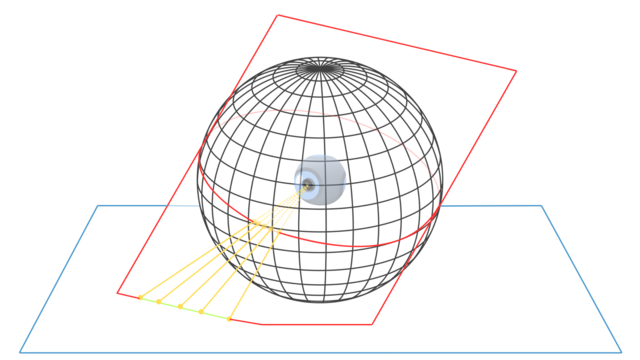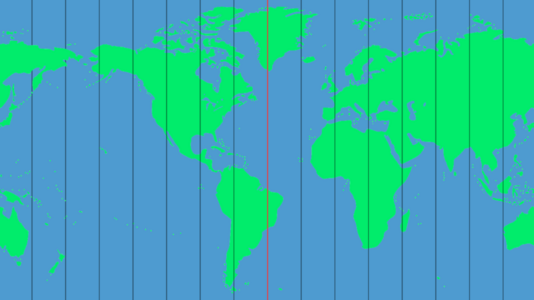Spherical Video PTZ: Getting Started - Projections Used
| Spherical Video PTZ |
|---|
 |
| Getting Started |
| User Guide |
| Examples |
| Performance |
| Contact Us |

|
Overview
This section provides the theoretical explanations of the Equirectangular and Rectilinear projections, which are used on the Spherical Video PTZ.
Equirectangular Projection
Equirectangular images, also referred to as 360° images, capture a panoramic view from a fixed point where the imaging system is positioned. These images encapsulate a complete 360° perspective, allowing all surrounding information to be displayed within a single flat image. To illustrate this concept, consider visualizing the Earth as a sphere and then "unfolding" it along the central meridian (shown by the red lines in the accompanying image). This "unfolding" process transforms the spherical surface into a plane image. Please note, that the resulting plane maintains a unique aspect ratio of 2:1, because of the vertical range covers 180° and the horizontal range covers 360° after the unfolding procedure.
-
Meridians on earth globe.
-
Meridians on earth map.
Rectilinear Projection
The Rectilinear projection, also referred to as the Gnomonic Projection, is a method used to project the surface of a sphere (or a 360° image) onto a plane. Typically, the plane onto which the surface points are mapped is tangent to the sphere at a single point. This projection is accomplished by using the center of the sphere as the projection point. It's important to note that the resulting plane does not intersect the center of the sphere. The diagram below provides a visual example of this process:

The term "rectilinear" in the Rectilinear projection refers to its use of straight lines for the projection. This means that lines that are parallel in the real world remain parallel in the projection. Additionally, it is worth noting that every great circle (which is the largest circle that can be drawn on any given sphere) is transformed into a straight line in the resulting plane during this projection process.


